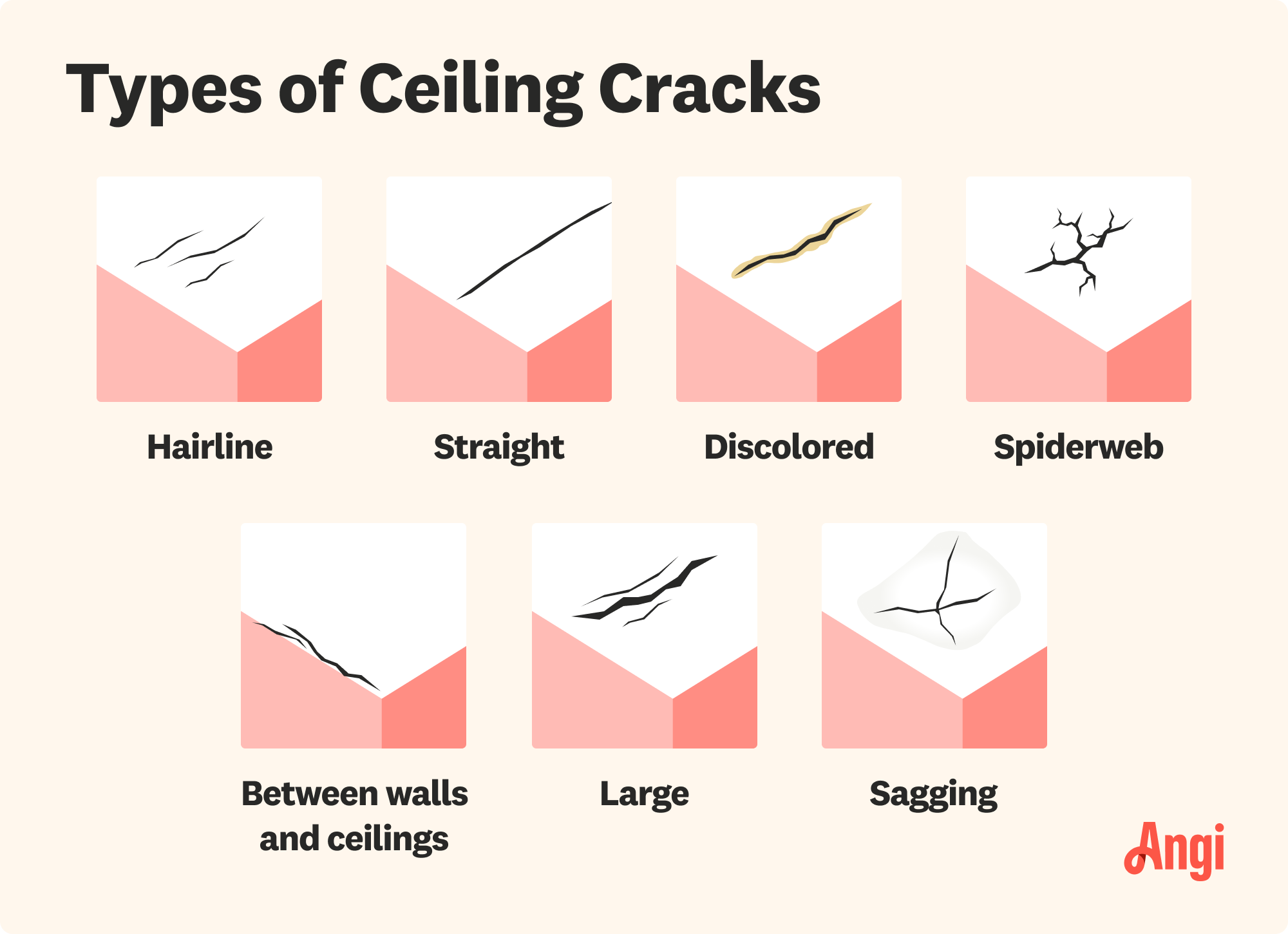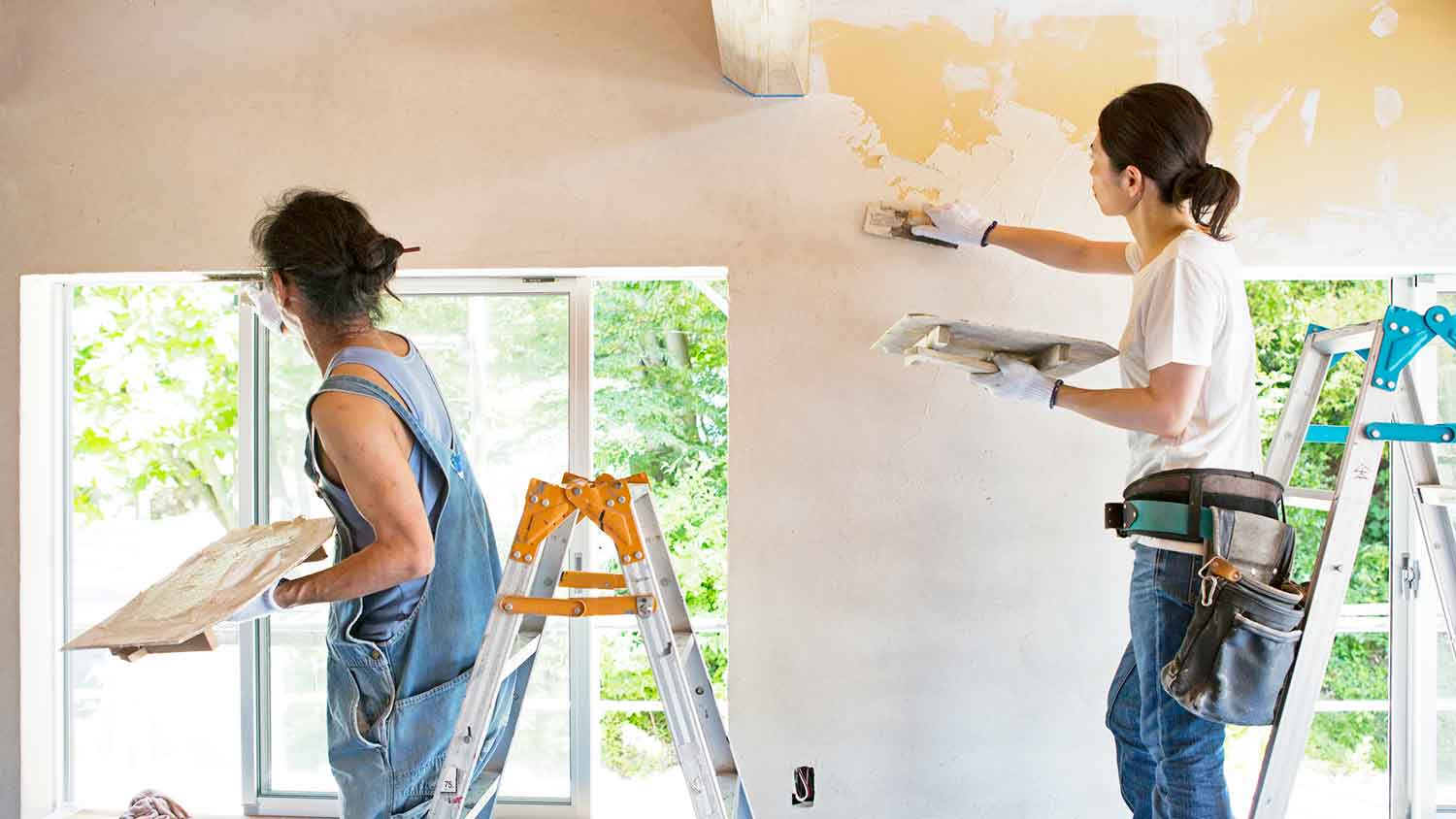
A ceiling repair averages about $1,000, but multiple factors affect this number. Learn more about creating an accurate ceiling repair cost estimate with our tips.
Take a crack at identifying your ceiling’s fine lines


Ceiling cracks aren’t just an eyesore—they can also be a sign of serious structural damage. Whether or not you need to take action depends on what’s causing the ceiling cracks in your home. Use this guide to the seven most common types of ceiling cracks to help you determine when you should hire a professional and when you can simply give your home a new coat of paint.


Hairline cracks are thin, resembling hair, and appear when temperatures or humidity levels fluctuate drastically. When this happens, the plaster swells or shrinks, resulting in harmless cosmetic cracks. You can easily cover this up with a fresh coat of paint, but remove flaky, old paint first to prevent hairline cracks from reappearing prematurely, as old paint can also contribute to hairline cracks.
| Feature | Description |
|---|---|
| Appearance | Fine, uneven, surface-level |
| Harm level | Minimal |
| Location | Walls and ceilings |
If you see straight cracks, there’s a good chance that the drywall was applied incorrectly during construction. If the installer didn’t use enough drywall plaster, then the drywall tape won’t adhere correctly, resulting in ceiling cracks along drywall seams—exactly where the drywall tape runs along the joints.
Although unsightly, straight cracks are another cosmetic issue that everyday DIYers can address themselves. Repairing ceiling cracks starts with cleaning the area, injecting joint compound beneath the loose drywall tape, and repainting the ceiling.
| Feature | Description |
|---|---|
| Appearance | Single, straight crack |
| Harm level | Minimal |
| Location | Drywall tape edges |
When yellow or brown discoloration accompanies your ceiling cracks, that means trouble—water damage trouble, to be precise. Discolored cracks can appear near plumbing via leaks and roofing or gutter problems. Though discoloration isn’t a direct sign of severe structural problems, if left untreated, leaks can cause serious and costly damage.
You’ll want to know who to call for a ceiling repair where there’s water damage. Hire a local plumber to handle leaks, and then follow up with a ceiling contractor to repair this type of ceiling crack.
| Feature | Description |
|---|---|
| Appearance | Yellow or brown cracks |
| Harm level | Moderate to extreme |
| Location | Anywhere leaks can occur |
Much like, well—a spiderweb—spiderweb cracks resemble webs, with one focal crack and several others leading away from the main crack. These types of ceiling cracks can vary in size and severity. Smaller cracks may be cosmetic or a sign of inferior workmanship.
For instance, if the person who applied the drywall to your home used too much, the drywall can crack from temperature and humidity fluctuations. Larger spiderweb cracks can signify a structural issue, such as foundation settling.
| Feature | Description |
|---|---|
| Appearance | Spiderweb-like cracks |
| Harm level | Mild to moderate |
| Location | Walls and ceilings |

Two types of cracks can occur between the wall and the ceiling. One is a crack that starts on the ceiling and stops at the wall. The other is a crack that runs from the ceiling down the wall. If you have the latter, then there’s a chance your home has structural damage, called truss uplift, that requires prompt attention. This is where your roof trusses shift due to changes in temperature or humidity. Fixing truss uplift is not a DIY project and can’t be solved with a simple coat of paint. It requires a pro to climb into the attic and disconnect the trusses from the interior walls.
| Feature | Description |
|---|---|
| Appearance | Long cracks that vary in size |
| Harm level | Moderate to severe |
| Location | Between the wall and the ceiling |
Large cracks of any kind usually mean structural damage—especially if they’re accompanied by sagging. In the case of sagging, this is a major warning sign of ceiling collapse. You should contact a local ceiling repair company pronto if you have ceiling cracks larger than 1/8th of an inch to rule out structural problems. Ceiling repair costs for cracks that aren’t cosmetic fall between $500 and $1,300 on average.
| Feature | Description |
|---|---|
| Appearance | Wider than 1/8 inch |
| Harm level | Moderate to severe |
| Location | Ceilings and walls |
Sagging ceiling cracks often appear in the center of the ceiling, indicating structural damage. These types of cracks can occur as a result of too much weight on the floor above, but water damage and foundation settling can also contribute to the sagging of ceiling cracks. Generally speaking, the larger the cracks, the worse the damage.
| Feature | Description |
|---|---|
| Appearance | Large, sagging cracks |
| Harm level | Severe |
| Location | Center of the ceiling |
Not all ceiling cracks are the same in terms of severity. It’s important to know the signs of a more serious problem before you take out your paint supplies and simply paint over the cracks. Here are signs that your ceiling cracks are the result of a structural issue:
Your doors and windows stick or close too easily.
The floors are uneven and sloped.
You see cracks in your flooring that cross multiple tiles or planks.
The walls appear bowed.
The moldings in your home are also cracked or displaced.
There are patio, stairway, chimney, garage, and/or driveway cracks.
Your home’s exterior masonry contains cracks.
There’s water in the basement.
Don’t wait for cracks to worsen. If you notice any of these signs coinciding with ceiling cracks of any type, contact a ceiling repair pro near you right away to get to the underlying cause.
First Premier Home Warranty offers excellent coverage options that suit various needs. I opted for their premium plan, and it has been worth every penny. From major appliances to essential systems, the coverage is comprehensive. When my dishwasher and microwave both needed repairs, I was...
Iâ ll called Luis for an estimate for a roof repair. He advised me to get a full roof replacement instead of a repair just case the roof was old and had multiple leaks around the house. We got more estimates from other contractors but what made Luis and his company different other contractor...
This is an excellent company the workmanship is superber and the people who work there are reliable friendly and pleasant and protectionists. They did the plaster work as thought they were finishing the Sistine Chapel. Best workman we have ever had. They built a flight of stairs leading...
Dardan arrived early and was very helpfull from the beginning. . He explained everything to us and then proceeded to flawlessly connected our diswasher, refrigerator water line and kitchen faucet. He cleaned up before he left I would definitely hire them again.
It was a very smooth and easy experience. The Standguard technicians were professional, helpful and had good suggestions. I am very happy with their service and would recommend them.
Rick, Charlie, and the company foreman Diego did a beautiful job restoring and painting the ceilings and plaster walls of our co-op apartment which is close to 100 years old. Throughout the process they listened to our questions and concerns, and assisted with other general contracting...
Edgar was great. Gave me a prompt estimate, came on time, performed the repair, cleaned up after himself... will definitely hire him for future repairs.
John did a great job repairing the plaster in our baby room. It was a mess and after he finished it looks brand new. He uses Benjamin Moore paints and other good brands. Takes care in his work. A+
This work was done in late summer 2019. The review is late in posting due to my own reluctance with social media; my apologies to Charlie and the crew at Rolling Stone for not being more timely with this review. A rotting wooden retaining wall (about 60' long) was replaced with a paver block...
Amazing work they're very professional
From average costs to expert advice, get all the answers you need to get your job done.

A ceiling repair averages about $1,000, but multiple factors affect this number. Learn more about creating an accurate ceiling repair cost estimate with our tips.

The eye-catching character of a coffered ceiling can really set your room design apart. This guide breaks down coffered ceiling costs to help you budget.

Venetian plaster can add depth and texture to your aesthetic. Learn how much Venetian plaster costs based on factors like square footage and whether you hire a pro to help.

Who does plaster work? A plasterer, of course—one who’s gone through years of training to master this subtle construction art. Here’s what you need to know.

Seeing a crack in your ceiling can be unnerving, but it’s not always cause for concern. Here’s how to repair ceiling cracks (and when to call a pro instead).

Looking to create a stunning statement with your wall design? Choose from popular types of plaster finishes for your walls to create the perfect atmosphere.